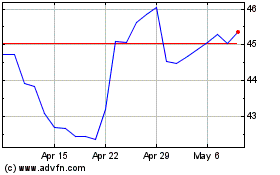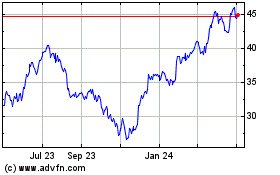Opel Took Backseat at GM as SUV Demand Surged
February 15 2017 - 11:32AM
Dow Jones News
By Mike Colias
In the seven years since General Motors Co. last considered
selling its European business, a major factor has changed: the
world has soured on passenger cars.
GM is in talks to potentially sell its Opel AG division to
Peugeot. The German unit, acquired by the Detroit auto giant 88
years ago, has served as a primary development hub for the sedans
and compact cars needed to satisfy demand in most markets and meet
emissions requirements.
Opel's role has diminished as low fuel prices turn consumer
demand away from cars toward the sport utilities or crossover
wagons American engineers are known for. Even in Europe, where cars
like Volkswagen AG's Golf or Ford Motor Co.'s Mondeo have long been
top sellers, auto makers are flooding the market with SUVs to
accommodate shifting tastes.
Certain passenger-car models, including redesigned Opel Astra
and Chevrolet Malibu, have been selling relatively well. But GM
executives said last month that selling more sedans actually hurts
overall margins in key regions, and the auto maker is cutting
production of certain models.
The Opel deal discussions "could indicate GM is further stepping
back" from passenger cars, a market "plagued by declining demand
and overcapacity," RBC Capital Markets analyst Joseph Spak wrote in
a research note shortly after talks were confirmed.
Opel has lost money since the late 1990s and having a large
sales operation in Europe forces U.S. auto makers to meet a
separate set of emissions rules than need to be met in their home
market. GM came close to selling the unit in 2009 to Canadian auto
supplier Magna International Inc., but backed off. It also
attempted to launch Chevrolet in Europe, but that effort
fizzled.
Keeping the car-engineering expertise and certain diesel-engine
development in house was a top reason for pulling out of the Magna
deal. About $8 billion in losses have been generated by GM Europe
since then, showing how costly that decision was.
In 2009 -- fresh off its U.S. government bailout and bankruptcy
-- GM had pressing need to improve a car portfolio that had long
lagged behind Toyota Motor Corp., Honda Motor Co. and other import
brands. It was the gas-price spike in 2008 that froze sales of the
Detroit Three's gas-guzzling SUVs and pickup trucks, pushing the
auto makers toward insolvency and highlighting the need for better,
fuel-efficient cars offerings.
That equation has been turned on its head in recent years amid
lower amid lower fuel prices, forcing GM and other auto makers to
cut production and offer profit-sapping discounts. The shrinking
importance of smaller cars and diesel engines in other parts of the
world means GM's scale in Europe "has become really difficult to
leverage" outside of the region, said one person familiar with GM's
operations.
The result is that better car lines haven't provided the
financial lift GM envisioned years ago.
For example, last year the auto maker rolled new versions of its
Chevrolet Cruze compact car and Malibu midsize sedan to critical
acclaim. Car & Driver magazine, for instance, rated the Malibu
higher than Toyota's Camry and Honda Accord, two cars that dominate
the segment.
Malibu and Cruze sales rose -- but that actually hurt GM's
overall profit margins in North America last year compared with the
prior year, when highly profitable trucks and SUVs made up a higher
percentage of sales.
GM isn't giving up on small cars, but it can rely on its
small-car development team at GM's South Korean engineering center,
acquired from Daewoo Motor in the early 2000s. The Chevy Bolt
electric vehicle -- released in December and touted by GM as a
symbol of its engineering prowess -- was jointly developed in South
Korea and suburban Detroit.
GM's growing China operations also are handling more car
development. In 2015, the company began spending $5 billion to
co-develop a global small-car platform with SAIC Motor Corp., its
largest joint-venture partner in China. That project will underpin
more than a dozen models to be sold in Brazil, Mexico, China and
other emerging markets starting in 2019.
Analysts say GM would need an infusion of new SUVs, commercial
vans and other new products to swing to a profit in Europe and
boost its market share beyond 6%, which is about one-third of what
GM has in the U.S. That would require an infusion of capital at a
time when the company is investing more heavily in electric
vehicles, self-driving cars and experiments in alternative forms of
mobility.
GM also faces uncertainty around the future of the EU and the
prospect of tightening environmental regulations in the wake of
Volkswagen's diesel-emissions scandal, which experts say could
ultimately force a costly shift toward EVs in Europe.
Write to Mike Colias at mike.colias@wsj.com
(END) Dow Jones Newswires
February 15, 2017 11:17 ET (16:17 GMT)
Copyright (c) 2017 Dow Jones & Company, Inc.
General Motors (NYSE:GM)
Historical Stock Chart
From Aug 2024 to Sep 2024

General Motors (NYSE:GM)
Historical Stock Chart
From Sep 2023 to Sep 2024
